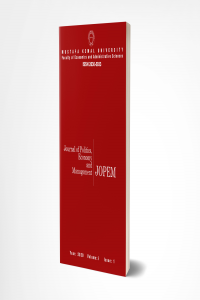Examining the dispossession concept through market inalienability: Mabo v Queensland (No 2)
Examining the dispossession concept through market inalienability: Mabo v Queensland (No 2)
This article presents a critique of the contemporary capitalist system, which promotes to trade every single item in accordance with the desire of people independent of the transferability of items by scrutinizing Radin’s market inalienability perspective to prevent dispossession. The applicability of the market inalienability argument in the context of the land law is argued in theory. The legal struggle of Aborigines has been considered by the Mabo case by enucleating the relationship between land and people from the historical and philosophical point of view in theory.
Keywords:
Dispossession, Land rights Market-inalienability,
___
- Beiser F. (1993). The Cambridge companion to Hegel. UK: Cambridge University Press.
- Bergström, A., Nagle N., Chen Y., McCarthy S., O Pollard M., Ayub Q., Wilcox S., Wilcox L., van Oorschot R., McAllister P., Williams L., Xue Y., Mitchell R., & Tyler-Smith C. (2016). Deep roots for aboriginal Australian Y chromosomes. Current Biology 26(6), pp. 809-13.
- Block, W. (1999). Market-ınalienability once again: Reply to Radin. Thomas Jefferson Law Review, 22(1)
- Butler, J., & Athanasiou, A. (2013). Dispossession: The performative in the political. Cambridge: Polity Press
- Byrd, S., & Hruschka J. (2006). Kant and Law. London and New York: Ashgate
- Chakravartty P., & Ferreira da Silva, D. (2012). Accumulation, dispossession, and debt: The racial logic of global capitalism – An introduction. American Quarterly 64(3), pp. 361-85.
- Davies, M. (2007). Property: Meanings, histories, theories. New York: Routledge Cavendish
- Erdem, F. (2018). A critique of dominant development tendency in the context of neoliberal policies. Ankara Hacı Bayram Veli University Journal of the Faculty of Economics and Administrative Sciences 20(2), pp. 441-55.
- Ertman M., & Williams, J. (2005). Rethinking commodification. New York: New York University Press
- Fraley, J. (2017). The meaning of dispossession. Indiana Law Review 50(2), pp. 517-38.
- Harvey, D. (2005). The new imperialism. UK: Oxford University Press
- Hegel, G. (2008). Outlines of the philosophy of right. UK: Oxford University Press
- Home, R. (2004). Outside de Soto’s Bell Jar: Colonial/Postcolonial Land Law and the Exclusion of the Peri-Urban Poor. In R. Home & H. Lim (Eds.), Demystifying the Mystery of Capital: Land Tenure and Poverty in Africa and the Caribbean (pp. 11-31). London: Routledge Cavendish.
- Johnson, D. ve Toft, M. (2014). Grounds for War: The Evolution of Territorial Conflict. International Security, 38(3), pp. 749-58.
- Keenan, S. (2017). Smoke, curtains and mirrors: The production of race through time and title registration. Law and Critique 28(1), pp. 87-108.
- Ksentini, F. (1994). Human rights and the environment. Geneva: United Nations
- Lefebvre, H. (1976). The survival of capitalism. New York: St. Martin’s Press
- Locke, J. (1690). Two treatises of government. London: Awnsham Churchill
- Mabo v Queensland (No 2) case (1992). 175 CLR 1 (No 2) High Court of Australia. http://www6.austlii.edu.au/cgi-bin/viewdoc/au/cases/cth/HCA/1992/23.html
- Machiavelli, N. (1998). The prince. UK: Cambridge University Press
- Marx, K. (2003). Capital: A critical analysis of capitalist production edited by Frederick Engels. New York: Lawrance & Wishart Ltd.
- Maurer, B. (1999). Forget Locke? From proprietor to risk-bearer in new logics of finance. Public Culture 11(2), pp. 365-85.
- Murray T. (1987). Gifts of the body and the needs of strangers. The Hasting Center Report 17(2) , pp. 30-8.
- Musambi, C. (2007). De Soto and land relations in rural Africa: breathing life into dead theories about property rights. Third World Quarterly 28(8), pp. 1457-78.
- Oliver, J., & Robison, L. (2017). Rationalizing inconsistent definitions of commodification: A social exchange perspective. Modern Economy, 8, pp. 1314-27.
- Park, K. (2016). Money, mortgage and the conquest of America. Law & Social Inquiry: Journal of the American Bar Foundation 41(4), pp. 1006-35.
- Polanyi, K. (1957). The great transformation. Boston, Massachusetts: Beacon Press
- Pottage, A. (1994). The measure of land. The Modern Law Review 57(3), pp. 361-84.
- Protocol 1 to the European Convention for the Protection of Human Rights and Fundamental Freedoms 1952. (Council of Europe) https://www.refworld.org/docid/3ae6b38317.html [accessed 19 April 2021]
- Proudhon, P. (1947). What is property?: An inquiry into the principle of right and of government. Dumfries and Galloway: Anodos Books
- Radin, M. (1987). Market-Inalienability. Harvard Law Review, 100(8), pp. 1849-1937.
- Russell, B. (2004). In praise of idleness and other essays. London and New York: Routledge
- Sabri, S. (2012). The discrepancy between the owners of land and superstructure and their suit against each other. International Research Journal of Applied and Basic Sciences 3(S), pp. 2678-81.
- Sichel, B. (1972). Karl Marx and the rights of man. Philosophy and Phenomenological Research 32(3), pp. 355-60.
- Watson, I. (2002). Buried alive. Law and Critique, Kluwer Law International 13(3), 253-69.
- Whitmore, C. (1896). The doctrine of the acquisition of territory by occupation in international law. Historical Theses and Dissertations Collection, Cornell Law School, Paper 365.
- Vismann, C. (2008). Files: Law and media technology. California: Stanford University Press.
- ISSN: 2630-5933
- Yayın Aralığı: Yılda 2 Sayı
- Başlangıç: 2018
- Yayıncı: Hatay Mustafa Kemal Üniversitesi
Sayıdaki Diğer Makaleler
Medikal turizme yönelik faaliyetler: Antalya’da bulunan hastanelerde bir araştırma
Semra ALTSOY, İlknur TAŞTAN BOZ
Examining the dispossession concept through market inalienability: Mabo v Queensland (No 2)
Sağlık ekonomisi çerçevesinde yetişkinlerde obezitenin sağlık harcamaları üzerinde etkisi
Maritime piracy and its impacts on international trade
The impacts of family background on children’s educational attainment and earnings
